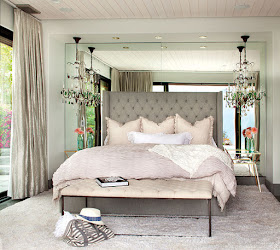I passed the
Pollock-Krasner House on a few occasions when I was in East Hampton and finally got a chance to visit on this last trip.
It's a modest wooden shingle style home, indicative of the Hamptons. Jackson Pollock (1912-1956) and Lee Krasner (1908-1984) were able to move out of their city apartment to the country with the help of Peggy Guggenheim, who lent them the money for a down payment.
 |
| ph: Pollock-Krasner Study Center |
 |
| ph: Hans Namuth |
Each artist had different approaches and styles, but were considered Abstract Impressionist painters in their own right. When they were not painting they enjoyed cooking, gardening, and entertaining.
Jackson and Lee celebrating with Stella Pollock. They understood "the power of the dinner party" and perfected their culinary skills ~ which later came in handy!
 |
| ph: from the Jeffery Potter Archives |
Portrait of Lenore Krassner (her given name), 1932 by Igor Pantuhoff, Lee's lover before she met Jackson.
Lee painted in an upstairs studio while Jackson took over the barn. She later moved into the barn after Pollock's death and her artwork took on a more liberated tone. She was mostly overshadowed by Pollock during his lifetime, but she came into her own in the 1960's and beyond.
The view from the back of the house with the studio on the left the property.
Pollock had hoped to turn this pile of rocks in the back of the house overlooking Accabonac Creek into something more one day; a sculpture of some kind?
The old barn was converted into a studio, and that's where the drip technique that Pollock is so closely identified with was perfected.
Jackson had many demons. His struggle with alcoholism was widely known, as was his volatile behavior. It may have been because he was bipolar. His Jungian therapist encouraged him to paint as a way to cope.
-
- "My painting does not come from the easel. I prefer to tack the unstretched canvas to the hard wall or the floor. I need the resistance of a hard surface. On the floor I am more at ease. I feel nearer, more part of the painting, since this way I can walk around it, work from the four sides and literally be in the painting."
 |
| ph: Rudy Burckhardt |
Jackson used his whole body to thrust the paint onto the canvas, thus preferring the floor or a wall to an easel. Ghosts of paintings past can be seen in the wooden floor of the studio. Like a work of art in itself, outlines of some noteworthy paintings have been identified within the boarders of an invisible canvas.
While the two were intrinsically tied, they were not together when Pollock died in a car accident; his mistress survived the crash. Lee lived and worked in the house and studio until her death. The Pollock-Krasner House and Study Center was bequeathed to the town.
A collection of recipes, some written in Pollock's hand, was collected by Robyn Lea and made into a cookbook. Published by
Asssouline, it is a nice collection of simple recipes with traditional ingredients. Photos of the home and art are juxtaposed with the recipes.
 |
| ph: Robyn Lea |
Here is a recipe from the book ~ Pollocks's award winning Apple Pie became famous in the Springs.
 |
| courtesy:Robyn Lea |
For the filling:
4 lb. Granny Smith apples, or any combination of
Tart apples
¼ cup water
1 cup sugar, or less if desired
1 tsp. cinnamon
½ tsp. nutmeg
1 tsp. all-purpose flour, sifted
For the pie crust:
2½ cups all-purpose flour
1 level tsp. baking powder
1 level tsp. salt
1½ cups cold butter
2 egg yolks, plus 1 whole egg for egg wash
½ cup cold milk, plus more as needed
To prepare the filling: Peel, core, and thinly slice apples. Stew apples in a pot with a little water to cover the fruit, plus the sugar and spices, until just cooked. Chill apples in a little of the juice. When cold, sift flour over the apples and stir gently
to combine. Set aside.
Preheat oven to 450°F. To make the pie crust: Combine flour, baking powder, and salt. Add butter and cut in until mixture is crumbly. Add egg yolks and mix with enough milk to make a dough. Roll out dough lightly. Place the pastry in a greased 10‑inch round pie dish, allowing pastry to overhang the edge of the pan by about 1 inch; trim away excess dough, roll it into a ball, and set aside to make the top crust. Be sure there are no cracks in the bottom crust; seal them by pressing edges together with fingers. Pour apple mixture into pie shell and distribute evenly.
For a simple top crust, roll out the remaining dough, slide the pastry sheet onto the rolling pin, and unroll it on top of the apple pie filling. Allow top crust to overhang the edge of the pan by about 1 inch; trim away excess dough, then pinch the top and bottom crusts together all around the rim to seal the pie. Prick the top crust with a fork in about a dozen places, or slice a few small openings with a knife, to allow steam to escape. Brush top pastry with egg wash and sprinkle lightly with a pinch or two of sugar.
For a more elaborate lattice-style top, roll out the remaining dough, cut into ½‑inch strips, and weave strips across the top of the filling. Brush lattice strips with egg wash and lightly sprinkle with a pinch or two of sugar.
Place the pie in the center of oven and bake 10 to 15 minutes, then reduce oven to 325°F and bake 25 to 30 minutes more.


















































